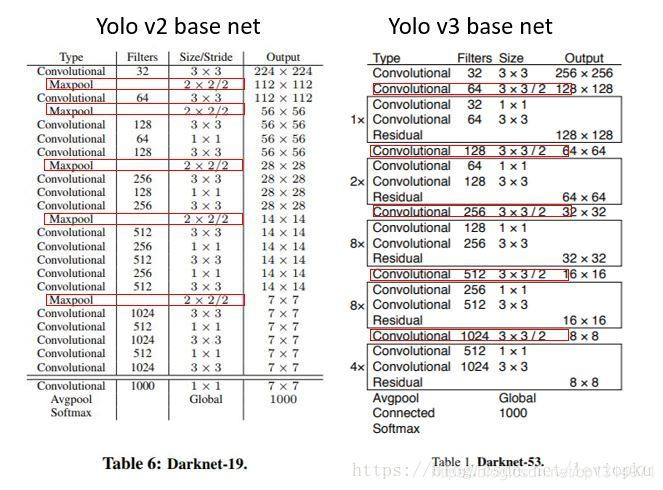摘要
目标检测算法yolo3应该算是复现难度比较小的,比起R-CNN,FAST-RCNN,FASTER-RCNN简单很多,越是最新的目标检测算法,越是容易复现,之前看过faster-rcnn的源码,有个roi-pooling这一板块使用c语言写的,加上版本torch0.4才行就放弃复现了,理解代码还是很有必要的。那么今天就开始学习yolo3,第一步是把每行的代码学懂。
darknet网络详解
首先看下darknet的网络形状,和一般的网络不通之处在于没有maxpool,darknet是通过stride=2来实现大小变化,还有一个residual这种小版块像resnet的捷径通道,将特征图融合,我们先看git的代码
代码理解
为了测试方便我把parse_model_config直接拿过来用了
from __future__ import division
import torch
import torch.nn as nn
import torch.nn.functional as F
from torch.autograd import Variable
import numpy as np
def parse_model_config(path):
"""Parses the yolo-v3 layer configuration file and returns module definitions"""
file = open(path, 'r')
lines = file.read().split('\n')
lines = [x for x in lines if x and not x.startswith('#')]
lines = [x.rstrip().lstrip() for x in lines] # get rid of fringe whitespaces
module_defs = []
for line in lines:
if line.startswith('['): # This marks the start of a new block
module_defs.append({})
module_defs[-1]['type'] = line[1:-1].rstrip()
if module_defs[-1]['type'] == 'convolutional':
module_defs[-1]['batch_normalize'] = 0
else:
key, value = line.split("=")
value = value.strip()
module_defs[-1][key.rstrip()] = value.strip()
return module_defs
class Upsample(nn.Module):
def __init__(self, scale_factor, mode="nearest"):
super(Upsample, self).__init__()
self.scale_factor = scale_factor
self.mode = mode
def forward(self, x):
x = F.interpolate(x, scale_factor=self.scale_factor, mode=self.mode)
return x
class EmptyLayer(nn.Module):
"""Placeholder for 'route' and 'shortcut' layers"""
def __init__(self):
super(EmptyLayer, self).__init__()
module_defs = parse_model_config("G:/3d\训练测试\PyTorch-YOLOv3-master\config/yolov3.cfg")
hyperparams = module_defs.pop(0)
output_filters = [int(hyperparams["channels"])]
module_list = nn.ModuleList()
for module_i, module_def in enumerate(module_defs):
modules = nn.Sequential()
if module_def["type"] == "convolutional":
bn = int(module_def["batch_normalize"])
filters = int(module_def["filters"])
kernel_size = int(module_def["size"])
pad = (kernel_size - 1) // 2
modules.add_module(
f"conv_{module_i}",
nn.Conv2d(
in_channels=output_filters[-1],
out_channels=filters,
kernel_size=kernel_size,
stride=int(module_def["stride"]),
padding=pad,
bias=not bn,
),
)
if bn:
modules.add_module(f"batch_norm_{module_i}", nn.BatchNorm2d(filters, momentum=0.9, eps=1e-5))
if module_def["activation"] == "leaky":
modules.add_module(f"leaky_{module_i}", nn.LeakyReLU(0.1))
elif module_def["type"] == "upsample":
upsample = Upsample(scale_factor=int(module_def["stride"]), mode="nearest")
modules.add_module(f"upsample_{module_i}", upsample)
elif module_def["type"] == "route":
layers = [int(x) for x in module_def["layers"].split(",")]
filters = sum([output_filters[1:][i] for i in layers])
modules.add_module(f"route_{module_i}", EmptyLayer())
elif module_def["type"] == "shortcut":
filters = output_filters[1:][int(module_def["from"])]
modules.add_module(f"shortcut_{module_i}", EmptyLayer())
module_list.append(modules)
output_filters.append(filters)
print(module_list)
parse_model_config()先整体看下这个函数,是将yolo3.cfg文件读取,读取成包含字典的列表
[{'type': 'net', 'batch': '16', 'subdivisions': '1', 'width': '416', 'height': '416', 'channels': '3', 'momentum': '0.9', 'decay': '0.0005', 'angle': '0', 'saturation': '1.5', 'exposure':
太长了,只放了一小部分
hyperparams = module_defs.pop(0)
去掉【】
for module_i, module_def in enumerate(module_defs):
module_i是从0开始的数值,module_def是一行行字典形式的数据,
通过几个if条件实现对cfg文件的读取到构建darknet网络
elif module_def["type"] == "route":
这一行代码其实是特征图的融合,通过加减操作到指定的特征图大小进行合并
在来看下输出
(0): Sequential(
(conv_0): Conv2d(3, 32, kernel_size=(3, 3), stride=(1, 1), padding=(1, 1), bias=False)
(batch_norm_0): BatchNorm2d(32, eps=1e-05, momentum=0.9, affine=True, track_running_stats=True)
(leaky_0): LeakyReLU(negative_slope=0.1)
)
(1): Sequential(
(conv_1): Conv2d(32, 64, kernel_size=(3, 3), stride=(2, 2), padding=(1, 1), bias=False)
(batch_norm_1): BatchNorm2d(64, eps=1e-05, momentum=0.9, affine=True, track_running_stats=True)
(leaky_1): LeakyReLU(negative_slope=0.1)
)
总共有106层
output_filters同样是记录经过每次卷积之后的特征图大小
正常版本的darknet
import torch
import torch.nn as nn
import time
class Conv2d(nn.Module):
def __init__(self, inc, ouc, k, s, p):
super(Conv2d, self).__init__()
self.conv = nn.Sequential(
nn.Conv2d(inc, ouc, k, s, p),
nn.BatchNorm2d(ouc),
nn.LeakyReLU()
)
def forward(self, x):
return self.conv(x)
class ConvSet(nn.Module): # inc->ouc
def __init__(self, inc, ouc):
super(ConvSet, self).__init__()
self.convset = nn.Sequential(
Conv2d(inc, ouc, 1, 1, 0),
Conv2d(ouc, ouc, 3, 1, 1),
Conv2d(ouc, ouc * 2, 1, 1, 0),
Conv2d(ouc * 2, ouc * 2, 3, 1, 1),
Conv2d(ouc * 2, ouc, 1, 1, 0)
)
def forward(self, x):
return self.convset(x)
class Upsampling(nn.Module):
def __init__(self):
super(Upsampling, self).__init__()
def forward(self, x):
return nn.functional.interpolate(x, scale_factor=2, mode='nearest')
class Downsampling(nn.Module):
def __init__(self, inc, ouc):
super(Downsampling, self).__init__()
self.d = nn.Sequential(
Conv2d(inc, ouc, 3, 2, 1)
)
def forward(self, x):
return self.d(x)
class Residual(nn.Module): # inc->inc
def __init__(self, inc):
super(Residual, self).__init__()
self.r = nn.Sequential(
Conv2d(inc, inc // 2, 1, 1, 0),
Conv2d(inc // 2, inc, 3, 1, 1)
)
def forward(self, x):
return x + self.r(x)
class MainNet(nn.Module):
def __init__(self):
super(MainNet, self).__init__()
self.d52 = nn.Sequential(
Conv2d(3, 32, 3, 1, 1), # 416
Conv2d(32, 64, 3, 2, 1), # 208
# 1x
Conv2d(64, 32, 1, 1, 0),
Conv2d(32, 64, 3, 1, 1),
Residual(64),
Downsampling(64, 128), # 104
# 2x
Conv2d(128, 64, 1, 1, 0),
Conv2d(64, 128, 3, 1, 1),
Residual(128),
Conv2d(128, 64, 1, 1, 0),
Conv2d(64, 128, 3, 1, 1),
Residual(128),
Downsampling(128, 256), # 52
# 8x
Conv2d(256, 128, 1, 1, 0),
Conv2d(128, 256, 3, 1, 1),
Residual(256),
Conv2d(256, 128, 1, 1, 0),
Conv2d(128, 256, 3, 1, 1),
Residual(256),
Conv2d(256, 128, 1, 1, 0),
Conv2d(128, 256, 3, 1, 1),
Residual(256),
Conv2d(256, 128, 1, 1, 0),
Conv2d(128, 256, 3, 1, 1),
Residual(256),
Conv2d(256, 128, 1, 1, 0),
Conv2d(128, 256, 3, 1, 1),
Residual(256),
Conv2d(256, 128, 1, 1, 0),
Conv2d(128, 256, 3, 1, 1),
Residual(256),
Conv2d(256, 128, 1, 1, 0),
Conv2d(128, 256, 3, 1, 1),
Residual(256),
Conv2d(256, 128, 1, 1, 0),
Conv2d(128, 256, 3, 1, 1),
Residual(256)
)
self.d26 = nn.Sequential(
Downsampling(256, 512), # 26
# 8x
Conv2d(512, 256, 1, 1, 0),
Conv2d(256, 512, 3, 1, 1),
Residual(512),
Conv2d(512, 256, 1, 1, 0),
Conv2d(256, 512, 3, 1, 1),
Residual(512),
Conv2d(512, 256, 1, 1, 0),
Conv2d(256, 512, 3, 1, 1),
Residual(512),
Conv2d(512, 256, 1, 1, 0),
Conv2d(256, 512, 3, 1, 1),
Residual(512),
Conv2d(512, 256, 1, 1, 0),
Conv2d(256, 512, 3, 1, 1),
Residual(512),
Conv2d(512, 256, 1, 1, 0),
Conv2d(256, 512, 3, 1, 1),
Residual(512),
Conv2d(512, 256, 1, 1, 0),
Conv2d(256, 512, 3, 1, 1),
Residual(512),
Conv2d(512, 256, 1, 1, 0),
Conv2d(256, 512, 3, 1, 1),
Residual(512)
)
self.d13 = nn.Sequential(
Downsampling(512, 1024), # 13
# 4x
Conv2d(1024, 512, 1, 1, 0),
Conv2d(512, 1024, 3, 1, 1),
Residual(1024),
Conv2d(1024, 512, 1, 1, 0),
Conv2d(512, 1024, 3, 1, 1),
Residual(1024),
Conv2d(1024, 512, 1, 1, 0),
Conv2d(512, 1024, 3, 1, 1),
Residual(1024),
Conv2d(1024, 512, 1, 1, 0),
Conv2d(512, 1024, 3, 1, 1),
Residual(1024)
)
'---------------------------------------------------------'
self.convset_13 = nn.Sequential(
ConvSet(1024, 512)
)
self.detection_13 = nn.Sequential(
Conv2d(512, 512, 3, 1, 1),
nn.Conv2d(512, 266, 1, 1, 0) # ?????????????????18
)
self.conv_13 = nn.Sequential(
Conv2d(512, 256, 1, 1, 0)
)
self.up_to_26 = nn.Sequential(
Upsampling()
)
'---------------------------------------------------------'
self.convset_26 = nn.Sequential(
ConvSet(768, 512) # 经concat,通道相加512+256=768
)
self.detection_26 = nn.Sequential(
Conv2d(512, 512, 3, 1, 1),
nn.Conv2d(512, 255, 1, 1, 0)
)
self.conv_26 = nn.Sequential(
Conv2d(512, 256, 1, 1, 0)
)
self.up_to_52 = nn.Sequential(
Upsampling()
)
'---------------------------------------------------------'
self.convset_52 = nn.Sequential(
ConvSet(512, 512) # 经concat,通道相加256+256=512
)
self.detection_52 = nn.Sequential(
Conv2d(512, 512, 3, 1, 1),
nn.Conv2d(512, 255, 1, 1, 0)
)
def forward(self, x):
x_52 = self.d52(x)
x_26 = self.d26(x_52)
x_13 = self.d13(x_26)
x_13_ = self.convset_13(x_13)
out_13 = self.detection_13(x_13_) # 13*13输出
y_13_ = self.conv_13(x_13_)
y_26 = self.up_to_26(y_13_)
'----------------------------------------------------------'
y_26_cat = torch.cat((y_26, x_26), dim=1) # 26*26连接
x_26_ = self.convset_26(y_26_cat)
out_26 = self.detection_26(x_26_)
y_26_ = self.conv_26(x_26_)
y_52 = self.up_to_52(y_26_)
'----------------------------------------------------------'
y_52_cat = torch.cat((y_52, x_52), dim=1)
x_52_ = self.convset_52(y_52_cat)
out_52 = self.detection_52(x_52_)
return out_13, out_26, out_52
if __name__ == '__main__':
trunk = MainNet()
x = torch.rand((1, 3, 416, 416))
y_13, y_26, y_52 = trunk(x)
print(y_13.shape)
print(y_26.shape)
print(y_52.shape)
darknet是输出三个不同大小的特征图,这三个特征图是有特征图结合的,在这种pytorch直接写出来看的更加明确,第一种读取cfg文件之后也会进行这一步的融合,只不过在后面才有所操作。
